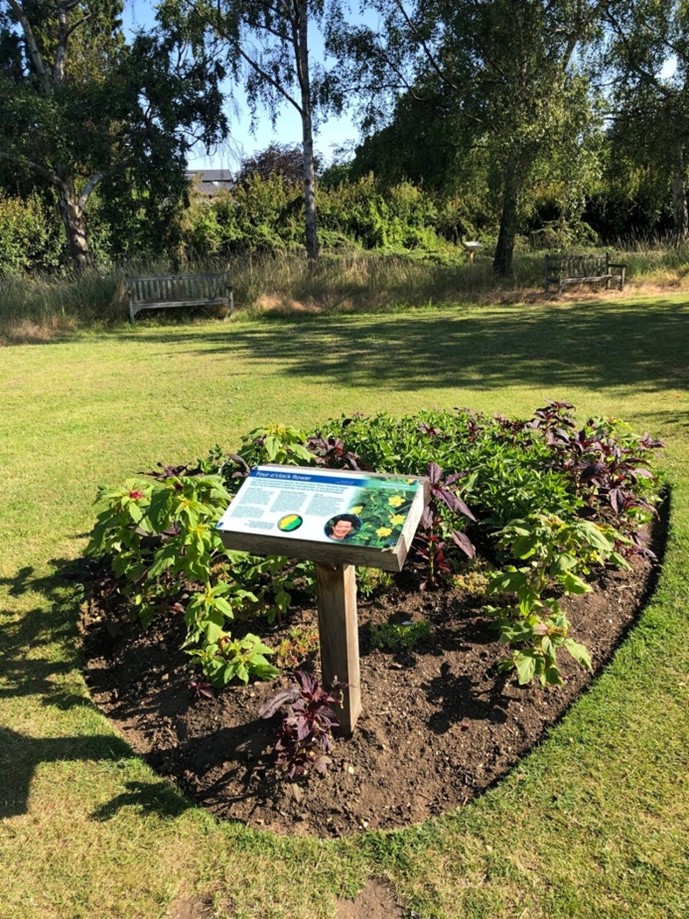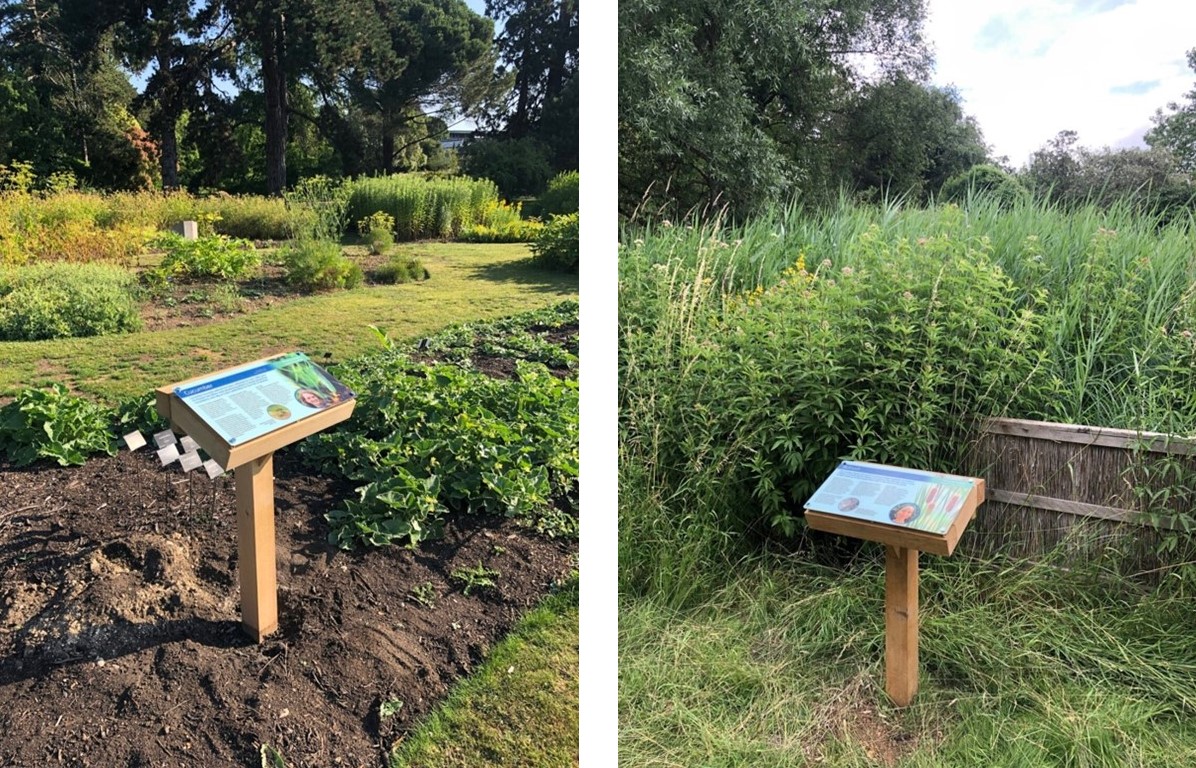FRIDAY, 15 DECEMBER 2023
As the warmth of summer is fast fading into the brisk cold of winter, something new is on the scene in the Cambridge University Botanic Garden (CUBG). While the leaves may be falling and the days grow shorter, 14 new display boards have popped up. What sets these boards apart is that the plants themselves share the spotlight with the researchers who study them. As a world-class research institution, Cambridge University boasts an incredible number of projects, many of which have some connection to our green friends. Over 8,000 species make up the Garden’s living collection, a treasure trove of resources and diverse range of plants from around the world to tap into when facing difficult but important research questions.The seed for this project was planted by the CUBG Learning Team and was supported by funding from Research England. With the rain pounding hard on my umbrella, I headed to the Garden for a whistlestop behind-the-scenes tour with Dr Hamish Symington, a postdoctoral researcher who has combined his passion for all things plants and public engagement to spearhead this new initiative. As I soon discovered, following the new Amazing People, Enquiring Minds trail may just change your perspective on what it really means to be a plant researcher.
 One of the Amazing People, Enquiring Minds boards of the trail
One of the Amazing People, Enquiring Minds boards of the trailHS: My approach was to dig through the websites of various departments to find researchers engaged in interesting plant-related projects. This includes not just conventional scientific departments like Plant Sciences, Biochemistry and Crop Sciences, but crossing over into societal and social disciplines with Architecture, Archaeology and even English! While some of the projects may lead directly to new applications in areas such as agriculture and healthcare, the benefits of others lie more in their contribution to creativity and collective knowledge. Diversity is a key theme among both plants themselves and plant researchers.
I specifically wanted to showcase researchers early on in their academic career – often in this sort of project there is an undue emphasis on senior researchers which skips right through the journey straight to the end of the career path. I want visitors to look at the featured researchers and see people just like themselves – and, particularly for our younger visitors, friendly and empowering role models giving them the message ‘You could be a researcher, too!’.
Bluesci: What does each board feature?
HS: The boards are placed next to plants that are relevant to particular research projects –from the towering Scots Pine to the humble potato. Rather than a fact-file on the plant itself, on each board you’ll find a summary of how that plant is used in research alongside some of the personal story of the researcher driving that project. You might read about what fascinates them about their favourite plant, or what makes them excited about what they do. Each board has a photograph of the researcher, and they’re not in white lab coats measuring chemicals into beakers – they’re normal-looking people doing amazing research. Visiting just a few of the boards really gives a feel for the huge diversity of both research projects and researchers themselves – there is no ‘typical’ researcher.
Bluesci: What do you hope people take away from the trail?
HS: I want to demonstrate the incredible range in both the research done at the University and the people themselves. I don’t think people realise that plant research goes far beyond the biological sciences, but plants really do find their way into every corner of academia. As mentioned earlier, I also want to break down common misconceptions about who ‘researchers’ are by focusing attention on those who often don’t have the same public and media presence as senior academics. There’s really no stereotype – all you need is a curious mind, strong motivation and a desire to find answers to the big questions we face in science and society overall.
Bluesci: How can our readers find out more?
HS: I’d encourage readers to visit the Garden and follow the trail! Entry is free for Cambridge University students and an amazing place to visit at any time of the year. There are two entrances, one on Hills Road and the other on Bateman Street. It’s open daily from 10am until 4pm (November to January), 5pm (February to March) or 6pm (April to September). Standard adult entry is just £7.20, with children up to 16, Friends of the Gardens, Cambridge University students and carers able to enter for free.
On your way in, pick up a free ‘Amazing People, Enquiring Minds’ trail booklet that’ll point out where each of the boards is located. Set yourself a challenge to try to find them all as you wander through the paths and take in all the Garden has to offer. You can also visit www.botanic.cam.ac.uk/amazingpeople if you’re not able to get to the Garden in person.
The Learning team has produced a range of many other trails too, ranging from plants and climate change to plants inspiring design and technology.
As the Garden opened its gates to the public, I headed to my own lab a short walk down the road. Even from just a snapshot of the full experience, my definition of a ‘plant researcher’ was certainly expanded and I felt truly proud to be part of such a diverse and inclusive University community. Even if the rain is pouring down, put on your waterproofs and umbrella, grab a hot drink at the Garden café and take a walk on the green side - you won’t see plant research in the same way again.
Bluesci’s Sneak Peek
After checking out a few of the boards, I was fortunate to be able to catch up with a few of the featured researchers to dive a little deeper into their plant-centric worlds.
Bluesci: What led you into this particular area of research?
Elin Falla: My PhD in computational plant epidemiology combines my love for plant science with my interest in both food security and programming. I am focusing on simulating plant disease spread across fields of crops.
Camila Alday: I have always been interested in people: their traditions, behaviours, and cultures. Archaeology, as a way to access social dynamics of the past, always fascinated me. Researching plant fibre for fabric and tools (e.g., fishing nets, and lines) in ancient South America came to me as an undergraduate project that began my research journey.
Bluesci: What excites you most about your project?
EF: I love that my project spans highly theoretical to highly applied aspects. The mathematical models I create are theoretical representations of reality, but I'm driven to make them represent the reality of disease spread, so their conclusions can be applied to real disease control scenarios.
CA: I have the privilege of examining ancient plant fibre remains, made by another human, which I can touch and observe. They can serve as fragments of a larger puzzle, narrating stories about technology and production systems for textiles and fabrics. These findings shed light not only on the use of plants for food, but also for clothing, garments and tools, showing that plants have played a multifaceted role across various dimensions in human societies throughout history.
Bluesci: What does your day-to-day job involve?
EF: Day-to-day, I'm mostly at my laptop coding or sitting with a pen and paper doing maths. Successfully creating a desired biological system from equations I've created is by far the most satisfying (as well as sometimes frustrating!) part of my day-to-day.
CA: I would say that fieldwork constitutes the most exciting aspect of my job, especially in remote locations like the Atacama Desert. When I am in the lab, I use microscopes to analyse fibre samples. Sometimes I do not know what I am actually looking at; I just see colours and patterns. That is also my favourite part of my job. I can dive deep into these unknown but perfectly composed images for hours.
Bluesci: What advice/message would you give to young people considering a degree/career in science?
EF: Don't be afraid to change subjects/specialisms within STEM throughout your education/career, until you find the area that most excites you.
CA: Especially to girls and young women, I want to emphasize that a career in research is not only possible but increasingly accessible with greater educational opportunities. Science opens doors to a world of exploration, discovery, and meaningful contributions to our collective understanding of the world.
 Elin and Calla’s boards next to their research models of cucumber and bulrush respectively
Elin and Calla’s boards next to their research models of cucumber and bulrush respectively